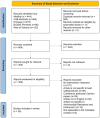Factors associated with antimicrobial resistant enterococci in Canadian beef cattle: A scoping review
- PMID: 37152689
- PMCID: PMC10157153
- DOI: 10.3389/fvets.2023.1155772
Factors associated with antimicrobial resistant enterococci in Canadian beef cattle: A scoping review
Abstract
Introduction: Antimicrobial resistance (AMR) is a global health concern, occurring when bacteria evolve to render antimicrobials no longer effective. Antimicrobials have important roles in beef production; however, the potential to introduce AMR to people through beef products is a concern. This scoping review identifies factors associated with changes in the prevalence of antimicrobial-resistant Enterococcus spp. applicable to the Canadian farm-to-fork beef continuum.
Methods: Five databases (MEDLINE, BIOSIS, Web of Science, Embase, and CAB Abstracts) were searched for articles published from January 1984 to March 2022, using a priori inclusion criteria. Peer-reviewed articles were included if they met all the following criteria: written in English, applicable to the Canadian beef production context, primary research, in vivo research, describing an intervention or exposure, and specific to Enterococcus spp.
Results: Out of 804 screened articles, 26 were selected for inclusion. The included articles discussed 37 factors potentially associated with AMR in enterococci, with multiple articles discussing at least two of the same factors. Factors discussed included antimicrobial administration (n = 16), raised without antimicrobials (n = 6), metal supplementation (n = 4), probiotics supplementation (n = 3), pen environment (n = 2), essential oil supplementation (n = 1), grass feeding (n = 1), therapeutic versus subtherapeutic antimicrobial use (n = 1), feeding wet distiller grains with solubles (n = 1), nutritional supplementation (n = 1) and processing plant type (n = 1). Results were included irrespective of their quality of evidence.
Discussion: Comparability issues arising throughout the review process were related to data aggregation, hierarchical structures, study design, and inconsistent data reporting. Findings from articles were often temporally specific in that resistance was associated with AMR outcomes at sampling times closer to exposure compared to studies that sampled at longer intervals after exposure. Resistance was often nuanced to unique gene and phenotypic resistance patterns that varied with species of enterococci. Intrinsic resistance and interpretation of minimum inhibitory concentration varied greatly among enterococcal species, highlighting the importance of caution when comparing articles and generalizing findings.
Systematic review registration: [http://hdl.handle.net/1880/113592].
Keywords: Enterococcus spp.; antimicrobial resistance; beef; cattle; scoping review.
Copyright © 2023 Strong, Marasco, Invik, Ganshorn, Reid-Smith, Waldner, Otto, Kastelic and Checkley.
Conflict of interest statement
The authors declare that the research was conducted in the absence of any commercial or financial relationships that could be construed as a potential conflict of interest.
Figures



References
-
- World Health Organization . Global Action Plan on Antimicrobial Resistance [internet]. Geneva, Switzerland: World Health Organization; (2015).
-
- Wall B, Mateus A, Marshall L, Pfeiffer D, Lubroth J, Ormel H, et al. Drivers, Dynamics and Epidemiology of Antimicrobial Resistance in Animal Production. Rome: Food and Agriculture Organization of the United Nations; (2016).
Publication types
LinkOut - more resources
Full Text Sources
Miscellaneous

